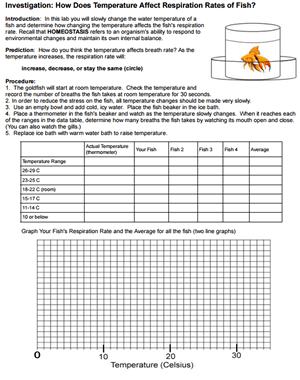
This investigation asks students to make a prediction about what will happen to the respiration rate of a fish if it is exposed to different temperatures. Students create water baths with ice water and record changes in fish respiration rate.
In the past, I have also done experiments with warm water, but found this stresses the fish. Goldfish have a good tolerance for the cold, but not for high temperatures. Plus, it simplifies the set-up if students only need to add ice water.
Feeder goldfish are inexpensive and can be purchased from local pet stores. If the temperature is changed very slowly, no harm will come to the fish, though it has been my experience that it is best to purchase a few extra.
At the end of the lab, I either place the goldfish in my classroom tank or give them away to students who have their own tanks.

 The Experiment
The Experiment
First, students obtain their fish in a 400 ml beaker. Note, you may want to pass them out without students choosing. Variations on the fish (like white spots) can result in drama over who gets what fish!
Then, give students a container with ice. I use plastic food storage containers for this. Students record the temperature with a simple alcohol thermometer. (Note, you many need to give instructions on how to read it.) For each temperature range, students observe fish respiration rate by counting the number of time the fish opens it mouth. They can also count gill openings.
After data is gathered, students take an average and create a line graph that shows how the respiration rate changed at the different temperatures. Analysis questions ask students to consider reasons why temperature changes respiration and why ectothermic animals would have different results than endothermic animals.
Grade Level: 9-10
Time Required: 1 – 1.5 hours
HS-LS1-2 Develop and use a model to illustrate the hierarchical organization of interacting systems that provide specific functions within multicellular organisms
HS-LS1-3 Plan and conduct an investigation to provide evidence that feedback mechanisms maintain homeostasis.

